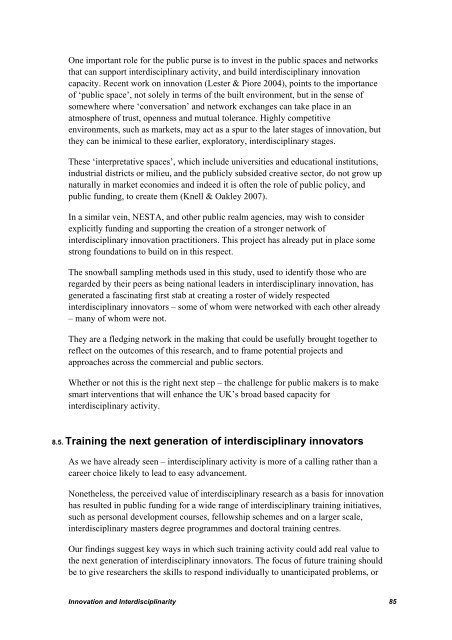Radical innovation: crossing knowledge boundaries with ...
Radical innovation: crossing knowledge boundaries with ...
Radical innovation: crossing knowledge boundaries with ...
You also want an ePaper? Increase the reach of your titles
YUMPU automatically turns print PDFs into web optimized ePapers that Google loves.
One important role for the public purse is to invest in the public spaces and networks<br />
that can support interdisciplinary activity, and build interdisciplinary <strong>innovation</strong><br />
capacity. Recent work on <strong>innovation</strong> (Lester & Piore 2004), points to the importance<br />
of ‘public space’, not solely in terms of the built environment, but in the sense of<br />
somewhere where ‘conversation’ and network exchanges can take place in an<br />
atmosphere of trust, openness and mutual tolerance. Highly competitive<br />
environments, such as markets, may act as a spur to the later stages of <strong>innovation</strong>, but<br />
they can be inimical to these earlier, exploratory, interdisciplinary stages.<br />
These ‘interpretative spaces’, which include universities and educational institutions,<br />
industrial districts or milieu, and the publicly subsided creative sector, do not grow up<br />
naturally in market economies and indeed it is often the role of public policy, and<br />
public funding, to create them (Knell & Oakley 2007).<br />
In a similar vein, NESTA, and other public realm agencies, may wish to consider<br />
explicitly funding and supporting the creation of a stronger network of<br />
interdisciplinary <strong>innovation</strong> practitioners. This project has already put in place some<br />
strong foundations to build on in this respect.<br />
The snowball sampling methods used in this study, used to identify those who are<br />
regarded by their peers as being national leaders in interdisciplinary <strong>innovation</strong>, has<br />
generated a fascinating first stab at creating a roster of widely respected<br />
interdisciplinary innovators – some of whom were networked <strong>with</strong> each other already<br />
– many of whom were not.<br />
They are a fledging network in the making that could be usefully brought together to<br />
reflect on the outcomes of this research, and to frame potential projects and<br />
approaches across the commercial and public sectors.<br />
Whether or not this is the right next step – the challenge for public makers is to make<br />
smart interventions that will enhance the UK’s broad based capacity for<br />
interdisciplinary activity.<br />
8.5. Training the next generation of interdisciplinary innovators<br />
As we have already seen – interdisciplinary activity is more of a calling rather than a<br />
career choice likely to lead to easy advancement.<br />
Nonetheless, the perceived value of interdisciplinary research as a basis for <strong>innovation</strong><br />
has resulted in public funding for a wide range of interdisciplinary training initiatives,<br />
such as personal development courses, fellowship schemes and on a larger scale,<br />
interdisciplinary masters degree programmes and doctoral training centres.<br />
Our findings suggest key ways in which such training activity could add real value to<br />
the next generation of interdisciplinary innovators. The focus of future training should<br />
be to give researchers the skills to respond individually to unanticipated problems, or<br />
Innovation and Interdisciplinarity 85

















